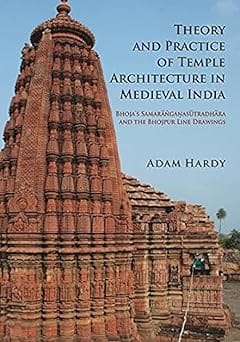WELCOME TO MIDLAND BOOK SHOP!
SHOP FOR
- Contemporary Fiction
- Contemporary Fiction
- Children
- Children
- Comics & Graphic Novels
- Comics & Graphic Novels
- Non-Fiction
- Non-Fiction
- Fiction
- Fiction
Shop No.20, Aurobindo Palace Market, Hauz Khas, Near Church +91 9818282497 | 011 26867121 110016 New Delhi IN
Midland The Book Shop ™
Shop No.20, Aurobindo Palace Market, Hauz Khas, Near Church +91 9818282497 | 011 26867121 New Delhi, IN
+919871604786 https://www.midlandbookshop.com/s/607fe93d7eafcac1f2c73ea4/677cda367903fd013d69b606/without-tag-line-480x480.png" [email protected]9789381406410 67938fa7683150002bb6315e Theory And Practice Of Temple Architecture In Medieval India https://www.midlandbookshop.com/s/607fe93d7eafcac1f2c73ea4/67938fa8683150002bb63166/71-4qjqbawl-_sy342_.jpg 9789381406410
292 line drawings and colored photographs. This book is about vatuvidya or architectural theory, the creation of temples, and the role of drawings as an indispensible bridge between the two. It focuses on two worls attributed to Bhoja, the legendary Paramara ruler of Malwa in the first half of the eleventh century. The first of these is his vastly ambitions, but unfinished, royal temple at Bhojpur, with its unique set of architectural drawings engraved in the surrounding rocks. These beautiful drawings, documented here for the first time, provide insights into construction processes and glimpses of hitherto unknown temple forms. They also hold the key to the intended design of the Bhojpur temple itself, which would have been by far the biggest Hindu temple in the world. The other main focus of this study is Bhoja s great compendium of architectural knowledge known as the Samaranganasutradhara, a project of comparable ambition to this temple. This famous Vastusastra was compiled at a moment when the classicl traditions of Indian architecture had blossomed into abundant maturity, and could be understood their diversity. The Samarangana s treatment of Nagara, Dravida and Bhumija temples are covered here in detail, with Key chapters translated both into English and into drawings of the temple designs that the next encapsulates. As illustrated by numerous photographs, the text description types known among urviving monuments, as well as many others probably never built. Far from being a straightjacket and an impediment to growth, the text is revealed both as a framework and a stimulus to further creativity. This book will allow the reader to begin to understand the temple architecture of medieval India through the eyes of its creatoINR
About the Author
Adam Hardy, an architect, is Professor of Asian Architecture at The Welsh School of Architecture, Cardiff University. He has been studying Indian temples for more than thirty years and his publications on the subject include Indian Temple Architecture: Form and Trans-formation (IGNCA, 1995) and The Temple Architecture of India (Wiley, 2007). Since 1999 he has been Editor of the journal South Asian Studies.He is currently working on two projects which, like the study for this book but in different ways, re-create traditional temples.
in stockINR 2800
1 1
Email ID already exists!
Your Current password is incorrect
Password Updated Successfully
Thanks for your Feedback
Theory And Practice Of Temple Architecture In Medieval India
ISBN: 9789381406410
₹2,800
₹3,500 (20% OFF)SIZE GUIDE
Sold By: Hauz Khas - Aurobindo Market
Details
- ISBN: 9789381406410
- Author: Adam Hardy
- Publisher: Dev Publishers
- Pages: 307
- Format: Hardback
Book Description
292 line drawings and colored photographs. This book is about vatuvidya or architectural theory, the creation of temples, and the role of drawings as an indispensible bridge between the two. It focuses on two worls attributed to Bhoja, the legendary Paramara ruler of Malwa in the first half of the eleventh century. The first of these is his vastly ambitions, but unfinished, royal temple at Bhojpur, with its unique set of architectural drawings engraved in the surrounding rocks. These beautiful drawings, documented here for the first time, provide insights into construction processes and glimpses of hitherto unknown temple forms. They also hold the key to the intended design of the Bhojpur temple itself, which would have been by far the biggest Hindu temple in the world. The other main focus of this study is Bhoja s great compendium of architectural knowledge known as the Samaranganasutradhara, a project of comparable ambition to this temple. This famous Vastusastra was compiled at a moment when the classicl traditions of Indian architecture had blossomed into abundant maturity, and could be understood their diversity. The Samarangana s treatment of Nagara, Dravida and Bhumija temples are covered here in detail, with Key chapters translated both into English and into drawings of the temple designs that the next encapsulates. As illustrated by numerous photographs, the text description types known among urviving monuments, as well as many others probably never built. Far from being a straightjacket and an impediment to growth, the text is revealed both as a framework and a stimulus to further creativity. This book will allow the reader to begin to understand the temple architecture of medieval India through the eyes of its creatoINR
About the Author
Adam Hardy, an architect, is Professor of Asian Architecture at The Welsh School of Architecture, Cardiff University. He has been studying Indian temples for more than thirty years and his publications on the subject include Indian Temple Architecture: Form and Trans-formation (IGNCA, 1995) and The Temple Architecture of India (Wiley, 2007). Since 1999 he has been Editor of the journal South Asian Studies.He is currently working on two projects which, like the study for this book but in different ways, re-create traditional temples.
User reviews
NEWSLETTER
Subscribe to get Email Updates!
Thanks for subscribing.
Your response has been recorded.

India's Iconic & Independent Book Store offering a vast selection of books across a variety of genres Since 1978.
"We Believe In The Power of Books" Our mission is to make books accessible to everyone, and to cultivate a culture of reading and learning. We strive to provide a wide range of books, from classic literature, sci-fi and fantasy, to graphic novels, biographies and self-help books, so that everyone can find something to read.
Whether you’re looking for your next great read, a gift for someone special, or just browsing, Midland is here to make your book-buying experience easy and enjoyable.
We are shipping pan India and across the world.
For Bulk Order / Corporate Gifting
 +91 9818282497 |
+91 9818282497 |  [email protected]
[email protected]
Click To Know More
INFORMATION
QUICK LINKS
ADDRESS
Midland Book Shop - Hauz Khas
Shop No.20, Aurobindo Palace Market, Near Church, New Delhi
Shop No.20, Aurobindo Palace Market, Near Church, New Delhi













